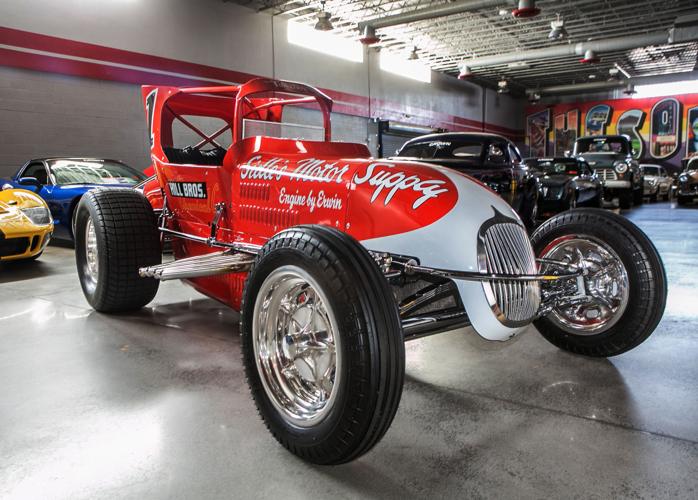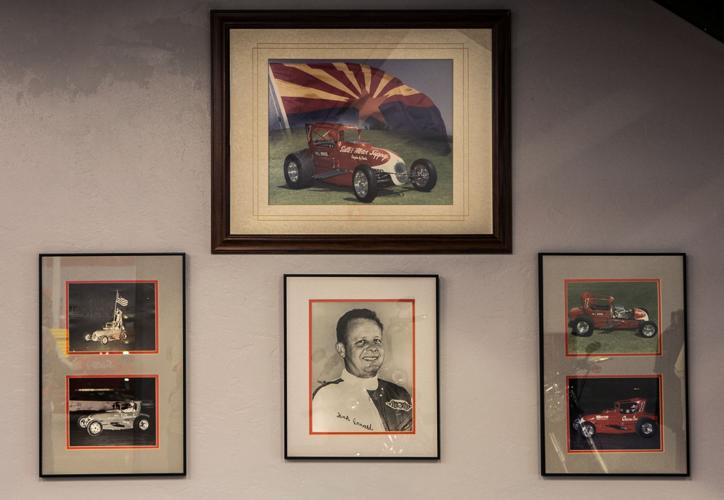If you walk among the 17,975 headstones at South Lawn Cemetery, one stops you in silence:
HENRY “HANK” ARNOLD
1931 – 1967
Beneath the letters is an engraving of a 1960s race car. It is the Twister. Next to the Twister is a trophy.
A few days after 36-year-old Arnold was killed at Phoenix’s Manzanita Race Track, his widow asked a funeral home man if it was possible to engrave a likeness of a car on Hank’s gravestone.
“Do you mean the Twister?” the man asked Roberta Arnold Chapman.
In the 1960s, Hank Arnold was surely one of the nine or 10 biggest names in Tucson sports. He began his move to prominence about a mile from where he is buried, winning a much-anticipated Main Event at the Tucson Rodeo Grounds on Sept. 10, 1955.
It’s not that Hank, just out of the Marines, won a featured race in front of a full house, almost 5,000 fans, it’s that he also beat future Indy 500 racers Roger McCluskey and Bill Cheesbourg.
Over the next 12 years, Arnold won more than 150 main events in Tucson, Phoenix, Albuquerque and places east and west. He built the Twister and Little Stinker and a half dozen other race cars that Tucson’s then-robust racing audience could identity as soon as he drove on any of the now-extinct Pima County auto-racing facilities.
“Hank was so good and so charismatic that he became my Michael Jordan growing up,” says Hal Burns III, a former racer and later manager of Tucson Raceway Park. “I was just a punk kid, but he’d let me sit in the Twister and make sounds like I was racing. He’d go, ‘Are you having fun?’ and just smile.”
A few days ago at Crown Concepts, a car-restoration center that has been housing the Twister, Burns joined Arizona Motorsports Hall of Famer Jimmy Blanton and Tucson race-car restoration expert Don Brown at what came off as a shrine to Hank Arnold.
The Twister, which Brown fully restored after locating the engine in Albuquerque and most of the rest of the car in Horse Cave, Kentucky, was in the showroom at Crown Concepts, about a mile from the old Gilpin Speedway, another of Arnold’s old haunts, which is now a gravel pit near Interstate 10.
Almost every race-night program from the first 49 Hank Arnold Memorial Races was on display at Crown Concepts, scattered over several tables. An 8x14 National Sprint Car Hall of Fame & Museum calendar features a full-color image of the Twister, dominating the December 2018 pages.
Arnold’s memory will dominate the 50th Hank Arnold Memorial Race Night on Saturday at Tucson Speedway. Woody Cummins, the track’s public-address announcer and PR man, said he expects about 4,000 fans, among them the three historians of Arizona racing, Burns, Blanton and Brown.
“Hank’s widow and his children will be in town for the 50th race,” said Brown, who hasn’t forgotten the day 50 years ago he heard about Arnold’s death.
“I was in the Navy then, in California. I came back to Tucson for the first Hank Arnold Memorial. I’ve been to almost all of them since. Why? Because he was my inspiration to race. He actually made me a part, unofficially, of his pit crew. I was just a kid who didn’t know a thing, but he treated me like part of the gang.”
Arnold mostly built the Twister in his backyard, as he did many of his cars. He worked in a radio and speedometer shop near the University of Arizona campus, and, later, a few months before he died, opened a tire shop on East 22nd Street, working with McCluskey, who started every Indy 500 race from 1961-79.
“A couple of weeks before Hank was killed, Roger had arranged to get him a car for the Indy 500,” Brown remembers.
“But Hank said no; his children were young and he didn’t want to go on the road. He also thought that Indy cars and USAC were too dangerous.”
Cummins and Brown believe the 50th Hank Arnold Memorial Race is the longest of its kind in America. It is a tribute to Tucson’s racing tradition, one that it won’t let go. After Arnold was inducted into the charter class of the Arizona Motorsports Hall of Fame in 1986, he was followed by contemporary Tucson racers McCluskey, Cheesbourg, Bob Huebner, Frank McDaniel, Red Greth and Carl Trimmer.
Blanton was working the fire crew at Turn 1 the night Arnold was killed at Manzanita.
“I saw his car roll, I saw his helmet get ripped off and bounce onto the track,” he remembers. “It was awful. He had no chance.
“Sadly, the same wreck wouldn’t kill him today. But in those days, the car survived and the driver died. The drivers of Hank’s generation were essentially daredevils. Guys today wouldn’t get into the Twister.”
An hour or so before the fatal crash, Arnold won the trophy dash at Manzanita. It was June 17, 1967. After first-responders attended to Arnold, and after an ambulance took his body to a coroner, officials at the track weren’t sure what to do with the big trophy awarded the winner of the dash.
It eventually found its way to Arnold’s widow, Roberta.
A few days ago, Brown stood next to the Twister in the showroom at Crown Concepts; he pulled something out of a box. It was the trophy from the Manzanita Speedway Trophy Dash, June 17, 1967.
“Hank’s wife gave it to me,” he said, emotionally, pointing to his heart. “All these years later, it still touches me right here.”





